27
The Bluetooth Market
27.1 Introduction
We are told by many people that the Bluetooth market is going to be huge. Forecasts suggest that we can expect to see half a billion Bluetooth-enabled devices by 2004, with a total market for Bluetooth components worth $2 billion in the same year. In this chapter, we will attempt to understand the truth behind these bold claims and try to explain the hype surrounding one of the most talked about technologies of the decade.
First of all, we will look more closely at what is going on in the consumer electronics industry what the consumers’ requirements (market pull) are, and indeed what the latest technology developments (technology push) have been.
27.2 Market Pull and Technology Push
In the last several years, the penetration of mobile cellular telephony has risen exponentially around the globe. The consumer has now reached a point where voice communications anywhere at any time are the norm. If one wants to ask a friend or colleague a minor question, perhaps “Did you book that holiday yet?,” then there’s no need to wait, just call them up right now. This exemplifies the “on-demand” nature of today’s society. The other major technological impact on today’s society is the recent Internet explosion; we now have vast amounts of information on-tap, hence the often coined expression “the information society”. E-commerce is all around us, and although it is only just now rolling out, the pace at which new services and Internet products are becoming available is incredible. These services and the Internet in general are maturing at an incredible rate with secure payment services, online shopping, and banking available from all the big name corporations.
As this book goes to print, we are poised on the edge of the mobile information revolution. In the next several years, the telephony on-demand scenario will give way to information on-demand. Instead of calling one’s friend to ask about the holiday, just surf the Web to the travel agent’s Web site, check out the streaming video, and book the holiday, paying for it by e-cash. This is already possible. Very soon, not only will we be able to do this while sitting in a field waiting for the next bus home using a shirt-pocket-sized smart phone or Personal Digital Assistant (PDA), we will expect to; it will be the norm.
The major cellular operators are rolling out the first enhanced rate packet data services such as GPRS1 and EDGE2 (so called 2.5 generation cellular), and the long awaited third generation cellular UMTS3 services are on the way. No longer will there be a dialup delay, and the data rates (144 kb/s to 2 Mb/s) will support full multimedia Internet traffic. Current estimates suggest that 30% of all Internet traffic will be mobile by 2005.
1General Packet Radio Services combine timeslots to provide higher data rates for GSM and adopt packet data for asynchronous communication, with no dial-up requirement.
2Enhanced data rates for GSM use deeper modulation to increase the basic data rate over GSM.
3Universal Mobile Telephony System is the next generation of high data rate cellular WAN for voice and data.
Enabling the “last meter” of connectivity from the cellular terminal to the handheld PDA is not the only application for Bluetooth, but it is going to be an important one. Blue-tooth in its simplest guise just removes the need for connecting cables. However, that simple concept has major repercussions. The effort required to find the mobile phone data cable, the cost of purchase, and even reading the manual to work out how to enable it are all obstacles to using the data capabilities of a mobile phone, or for that matter, of plugging a PDA into a laptop to synchronise it. By removing the cables, Bluetooth allows all these things to occur without the user needing to know. In fact, the success of Bluetooth will be measured more by the number of people who don’t know of its existence than by those who do!
A logical extension of this is to take a look at an existing cellular phone handset and ask some fundamental questions regarding its use. Many people already carry some form of information appliance such as a PDA or organiser, which has a more superior screen than the cellular phone and is more intelligent. So why carry two devices which are necessarily large enough to fit the human form factor, i.e., keypad, display, earpiece/mouthpiece? Figure 27–1 shows how Bluetooth would allow the familiar cellular phone to be broken up into its constituent parts. We are left with the smallest possible cellular “access node” that would fit neatly on a belt clip, a large screen, but small form factor touchpad PDA, an earpiece/earring, and a clip-on microphone with a call action button. This concept is sometimes referred to as wearable technology! Already wristwatch sized display driven by wireless links exist. The technology is here, mass market products will follow.
Figure 27–1 Breaking up the cellular phone.
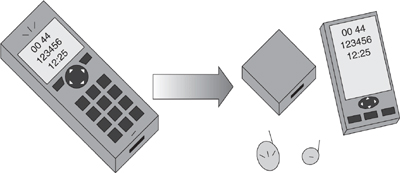
The alternative viewpoint is that the cellular phone itself becomes the information appliance, the so-called smartphone. This is also a valid supposition—already we see devices such as the Sony Z5 and Nokia communicator offering browsing capabilities and blurring the lines between phone and PDA. We will see both scenarios, with different consumers opting for whatever suits them best. In this case, the central information appliance will still need to communicate with other devices around it like the headset, PC, camera, camcorder, and printer.
Figure 27–2 Personal Area Network (PAN).

These scenarios lead us to the situation depicted in Figure 27–2, where the user is surrounded by electronic devices which either require data input or provide data output (data sink or data source) in the personal space, or indeed, even on the user’s person. This is now commonly referred to as the Personal Area Network (PAN).
Increasingly, we are interacting with more information appliances and becoming more connected to the Internet. Bluetooth enables us to be permanently connected with all these devices and the Internet without even knowing it. The effort factor will be virtually zero when we see something on the television and decide to pick up our PDA to select the “more info” tick box. When we wish to put our holiday pictures on our laptop and email them, we will not need to plug anything in; we won’t even need to find the camera. As long as it’s in range, we will just wirelessly connect to it.
27.3 Market Segments
Mobile cellular handsets are currently the largest consumer electronics market. With the proliferation of wired headsets now in use, this market sector is fairly well-assured. Other applications listed below will evolve over time as the technology becomes known and trusted through early adopters such as the mobile professional. Then, mainstream customers such as business users will move into the market, causing volumes to increase greatly and driving prices down. As prices drop, the technology becomes viable for new areas and opportunities as exemplified by the wireless home. Table 27–1 describes these segments while Table 27–2 lists the various application areas.
Ultimately, the home area networking (HAN) and personal area networking (PAN) paradigms can be realised as the technology becomes all-pervasive (Figure 27–3), but only if the key performance metrics of cost, autonomy, and ease of use are first met.
Table 27–2 describes the various areas of the market where Bluetooth promises to deliver. Cable replacement is the classic first target for Bluetooth as we described above.
Data and voice access points are a logical development, enabling connectivity between the Bluetooth-enabled device and the office LAN, private networks, and the Internet. The development of Bluetooth as a wireless voice telephony system, however, is dependent on a number of factors, as was noted in the chapter on related technologies. The emergence of Voice Over IP (VOIP) for low-cost long-distance calls via the Internet or LAN-based in-building telephony may catalyse this.
Table 27–1 Market Segmentation

Table 27–2 Product Categories and Applications

Figure 27–3 How PAN fits into the overall network.

Finally, ad-hoc networking based on existing wireless LAN technologies like IEEE 802.11 has been around for a little while now. Bluetooth professes to offer similar capabilities, although with certain limitations. However, its low cost, small form factor, and ease of use will make possible a whole plethora of applications and services all based on the notion of ad-hoc connectivity and interactivity, such as multiplayer games, automated vending, and transparent data exchange.
27.4 Success in the Marketplace
Bluetooth absolutely must be easy to use straight out of the box with little or no configuration required; indeed, it should not need to ship with an instruction book! Power consumption must be sufficiently low that a Bluetooth enabled device does not need to be left to charge significantly longer than a nonenabled device. The MMI must be highly intuitive, i.e. “Do you want to connect to: Dave’s PDA, the laser printer, the fridge?”
Interoperability is the most important issue of all. There will be many different Bluetooth solutions from different suppliers built in to a whole plethora of different devices. This in itself is very positive, since the consumer demands choice and multiple availability; one solution, form factor, or colour will never suit everyone. However, this makes the job of guaranteeing interoperability an onerous task. All devices in the public domain must work together seamlessly and transparently, avoiding the pitfalls which IrDA experienced in its early days.
At the time of this second edition, the level of interoperability between Bluetooth products is very good indeed. At the first unplugfest event, in mid 1999 when the technology was still very young, fifteen organisations showed up and, although the level of interoperability was not high, there was a basic level of information exchange and discussion. At the second event in early 2000, 250 organisations made it, and this time, only working products with a basic level of interoperation with Ericsson’s development kits were admitted. Overall, the success rate was around 70%. Since then, during 2000 and 2001, there have been four more such events with many more products and participants and the results have only got better. These events will continue and are particularly invaluable in identifying application level issues between different ways of managing and configuring the Bluetooth stack. They also play their part in maintaining the high level of interoperability now attained through the evolution of the Bluetooth specification.
The whole question of partitioning between—even the emergence of—the PAN/ HAN and how that impacts or not on the classic Wireless LAN one might expect to find in the office environment is undecided right now. Bluetooth may occupy a very useful niche as the PAN and as such the volumes will be huge as we have already described. However, if, as described in the chapter on related technologies, Bluetooth evolves upwards, it might well become the integrated PAN and HAN and even give the established WLAN incumbents a run for their money.
During 2001 there has been much discussion regarding the interaction of IEEE 802.11b and Bluetooth both in the same radio spectrum and in the same market. The spectrum coexistence question is being addressed both in proprietary solutions and in the standardisation world with IEEE802.15.2 and efforts within the SIG. The market coexistence is, however, more hotly debated. Essentially, 802.11b represents a true WLAN suitable for high speed peer to peer networking but represents a high power consumption and higher cost system, where interoperability is not guaranteed and product qualification is not available.
Bluetooth does not compete head-on with WLANs, but if it has the right price point and meets consumer needs, then perhaps small clustered office piconets will facilitate the entire printer and disc sharing required in small offices. A Bluetooth LAN access point might then provide a connection to the backbone or wider area WLAN.
As another example, a traveller in a public space, such as an airport, might use a PDA or smartphone via Bluetooth and associated access points to access flight details, book tickets, and browse sales offers, but then sit down to use his or her 802.11enabled laptop computer to surf the Web and view video-mails via other WLAN access points. The point is that a smartphone or PDA type of device will not bear the cost and power consumption requirements of a true WLAN subsystem, but will likely already include Bluetooth for its PAN needs.
Both of these examples show how Bluetooth and 802.11 may overlap with each other but offer specifically different costs and benefits. Indeed, there is sufficient benefit from both technologies that some manufacturers are already looking at combining both technologies in dual-mode devices.
Already there are a large number of Bluetooth components available, including single chip devices, two chip devices, and integrated modules. Sites such as BlueUnplugged.com retail Bluetooth connectivity products. Many products are already commercially available, including:
- PCMCIA Cards from IBM, Toshiba, Xircom, Brain Boxes Fujitsu, and TDK.
- Compact Flash Cards from AnyCom, Fujitsu, and Sunderland.
- USB and RS232 adapters from AnyCom, Sunderland, and TDK.
- Cellphones from Ericsson and Nokia.
- Headsets from Ericsson and Plantronics.
- Printer dongles from Anycom.
- Access points from Red-M, Axis, Widcomm, Anycom PicoBlue, and Ericsson.
- Add ons for PDAs from Red-M, TDK, and AnyCom.
- Laptops with embedded Bluetooth from Toshiba, IBM, Compaq, Sony, and Fujitsu.
More products are emerging onto the market. These are backed up by developers tools with ever-increasing functionality, such as CSR’s Bluelab which lets you develop software to build embedded applications running on a single chip Bluetooth system. Development kits are also available from many companies well known in the Bluetooth world such as Ericsson, Widcomm, and Silicon Wave. IP suppliers such as TTPCom and Tality also provide development tools and evaluation boards to ease integration of Bluetooth IP into products. The wide choice of sophisticated development tools combined with new profiles is fueling developments in next generation Bluetooth enabled products.
27.5 Enabling Technologies And Components
As we discussed in the chapter on implementation, there are various ways of creating a Bluetooth solution. Single-chip solutions facilitate simple, quick, and low cost deployment, and most importantly, the inclusion of Bluetooth in high-volume products which would not typically incorporate such advanced4 technology. Products such as toys or in-building electrical controls, for example, are in this category.
4And difficult to implement in a low-technology product where RF PCB techniques are not readily available.
Two-chip solutions (RF + digital link control/baseband) will facilitate choice and flexibility of RF source, providing for more powerful or higher quality radio systems suitable for WLAN applications, for example. Embedding the Bluetooth specific technology inside an existing ASIC for SOC levels of integration will become crucial in the longer term to enable some of the more exciting applications of Bluetooth, such as Bluetooth enabled multiplayer game pads, ultralow cost headsets, or even Bluetooth headset earrings and other wearable wireless jewellery!
The key to successful product development for Bluetooth has to be cost. For many applications, Bluetooth is replacing a piece of wire which costs a few cents. Of course, it adds some additional value, but until the market is won, this is a hard sell to the consumer. There is much talk of the $5 Bill Of Materials (BOM) cost adder, which basically results from the belief that a consumer might pay $39 retail for a Bluetooth headset as opposed to $29 for a wired headset, assuming a 200% markup between BOM and retail price. The graph in Figure 27–4 gives some indication of the likely drop in cost both for silicon and the total added BOM cost due to extra components like antenna and passives. Most people agree that $5 is achievable.
Figure 27–4 Projected silicon and BOM costs for Bluetooth.
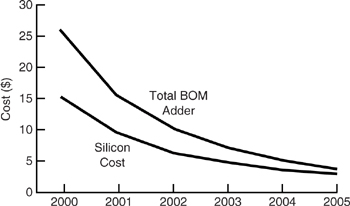
At the time of publication, many companies had announced products or develop-ment/licensing partnerships. Broadly speaking, there are silicon components available in the shape of single or dual chip solutions, IP solutions available for license, and development kits and radio test or protocol analysis equipment available. Modules are available to speed integration into new products. The number and range of consumer products under development is truly bewildering, with each exploiting the various component solutions in different ways to add value to the product.
27.6 Consumer Products
The first devices to appear on the market were external add-on modules. For cellular phones, these were add-on “dongles,” which plugged into the bottom of the phone, or “smart batteries,” which added Bluetooth functionality inside the battery pack. For PDAs, there are compact flash devices and Bluetooth enabled cradles; for laptops and some palmtop devices PCMCIA cards are available.
Already these add-ons have been followed by laptops and phones with built in Bluetooth, and amongst headset manufacturers the emphasis has moved from overcoming technical difficulties to getting the best styling.
As the Bluetooth data rate evolves upwards, it will become suitable for other applications such as the AV/multimedia applications discussed in the related technologies chapter. These and other applications are driving new profiles being defined within the Bluetooth SIG.
It was already mentioned in the introduction that GPRS and UMTS will have a major effect on Bluetooth, and vice versa. The timeline in Figure 27–5 gives projected dates for these service rollouts and an indication of how Bluetooth will itself roll out over the next few years. If this pace is kept up, we are likely to see the kinds of product volumes which many people have bullishly been talking about for some time now, as shown in Figure 27–6. With reports of Bluetooth chip volumes reaching millions per month, the predictions are already beginning to be realised.
Figure 27–5 Timeline for Bluetooth technology rollout.
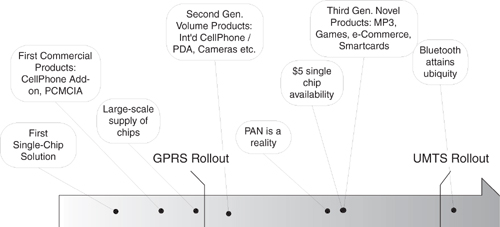
Figure 27–6 Projected volumes of Bluetooth-enabled devices.
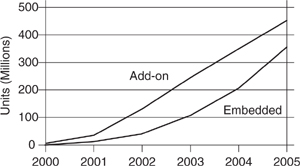
27.7 The Bluetooth Brand
It is well known that a brand portrays a powerful message in the marketplace. Already the Bluetooth name has become well known and understood to relate to wireless connectivity and freedom. By developing the name into a brand and providing a Bluetooth brand book with guidance on the use of the mark and logo, the SIG has tried very hard to give Blue-tooth a consumer brand image which will guarantee its success in the marketplace.
The brand book forms part of the Bluetooth specification and describes how the brand should be used. It is available from the Bluetooth Web site at http://www.Blue-tooth.com, and manufacturers producing Bluetooth devices must comply with the rules which it describes in just the same way that they must comply with the rest of the Blue-tooth specification.
The Bluetooth combination mark is shown in Figure 27–7, it consists of the figure mark and the word mark. In addition to the marks there is also a tagline and jingles.
Figure 27–7 Two forms of the Bluetooth wordmark.
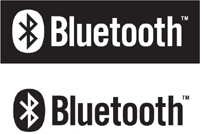
27.7.1 Legality
By tying in use of the brand with the qualification procedure which itself is essential for obtaining free rights to essential Bluetooth IP, only quality devices which correctly implement the standard may be marked with the name Bluetooth. Conversely, if something is not so marked, it is not qualified and is thus in breach of the essential IP licensing arrangements. So, the brand may only be applied to approved, tested devices and the mark effectively has legal significance and can be used to facilitate prosecution of pirates.
27.7.2 Consumer’s View
The brand reinforces the presence of Bluetooth technology in the market, making it clear that there is widespread availability of compatible devices. Through conformance testing, the brand is associated with the Bluetooth profiles and indicates that a product has been through testing, serving as a quality mark and effectively providing a badge of interoper-ability. The brand is designed to be used so as to make it clear that Bluetooth is not proprietary, but has many adopters.
27.7.3 Manufacturer’s View
The Bluetooth brand adds value to a product, adding the overall Bluetooth marketing message for the product in question and indicating that the product has enhanced functionality. The compatibility guarantee associated with the brand widens potential markets, i.e., the consumer knows that one headset will work with many different handsets. This interoper-ability is vital for Bluetooth technology to deliver on its ad-hoc networking promise.
27.8 Summary
There are a great many opportunities for Bluetooth-enabled products that exploit the various features of the technology as described in Table 27–3 to add value. However, there are many factors which could work against it. Potentially competing technologies, such as HomeRF and to a lesser extent 802.11, or even IrDA, could cause consumer confusion and at worst push Bluetooth into a niche corner. However, both HomeRF and 802.11 have said they are working to form a cooperative harmonisation between the technologies, though how that will work out remains to be seen.
Table 27–3 Bluetooth Features and Limitations
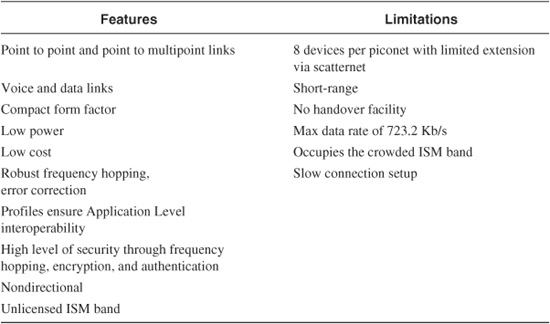
For manufacturers, the cost of the technology is paramount. For Bluetooth to become ubiquitous, it must be built into mass market products, not just the high-end models.
For consumers, poor interoperability and/or poor user experience could be a major problem for Bluetooth and cause it to falter. The well-discussed “Out Of Box Experience” (OOBE) has to be seamless and simple.
Whatever happens, one thing is sure. Bluetooth will be big, spectacularly big—either as a consumer flop, or as a massive success. We think it most likely the latter.
